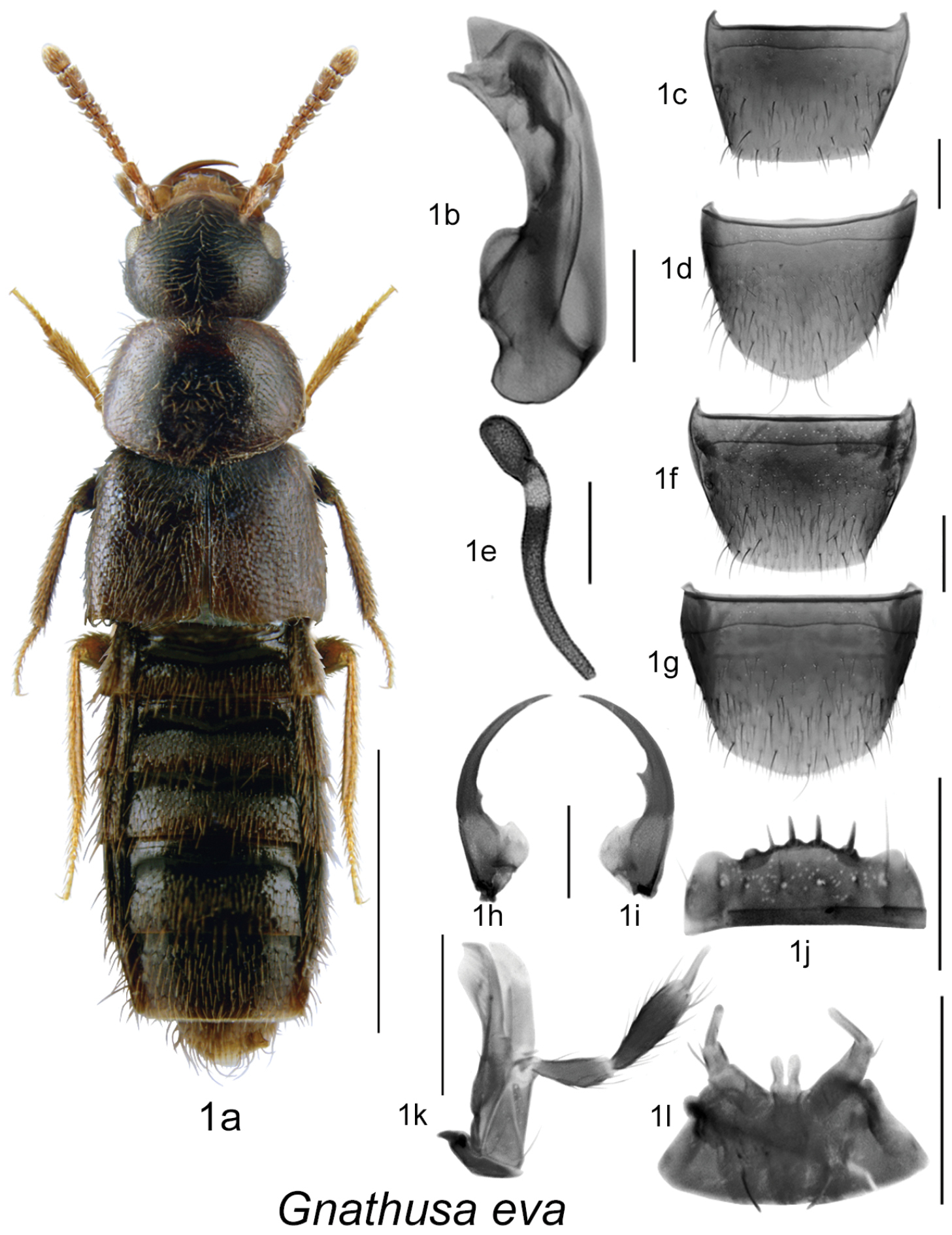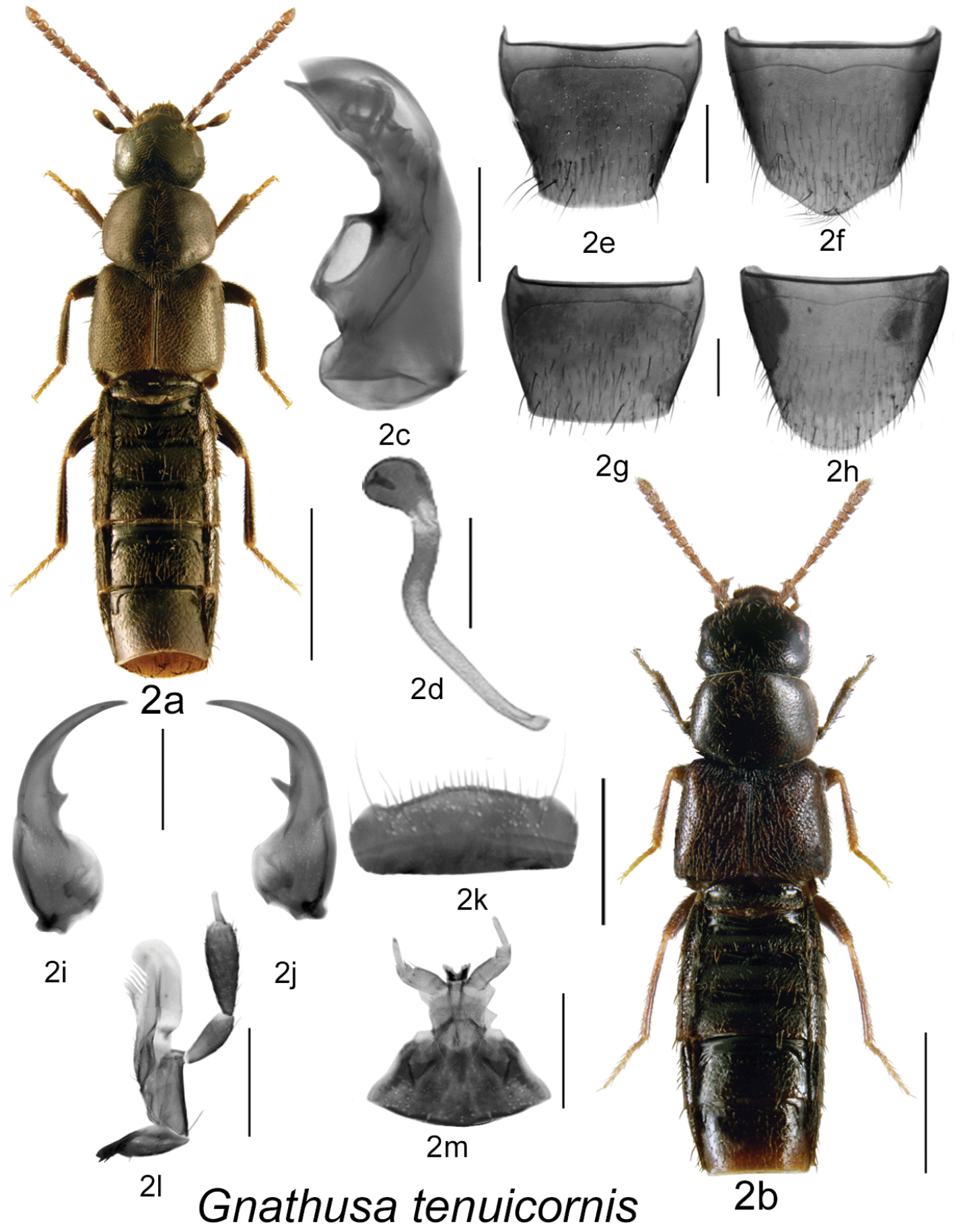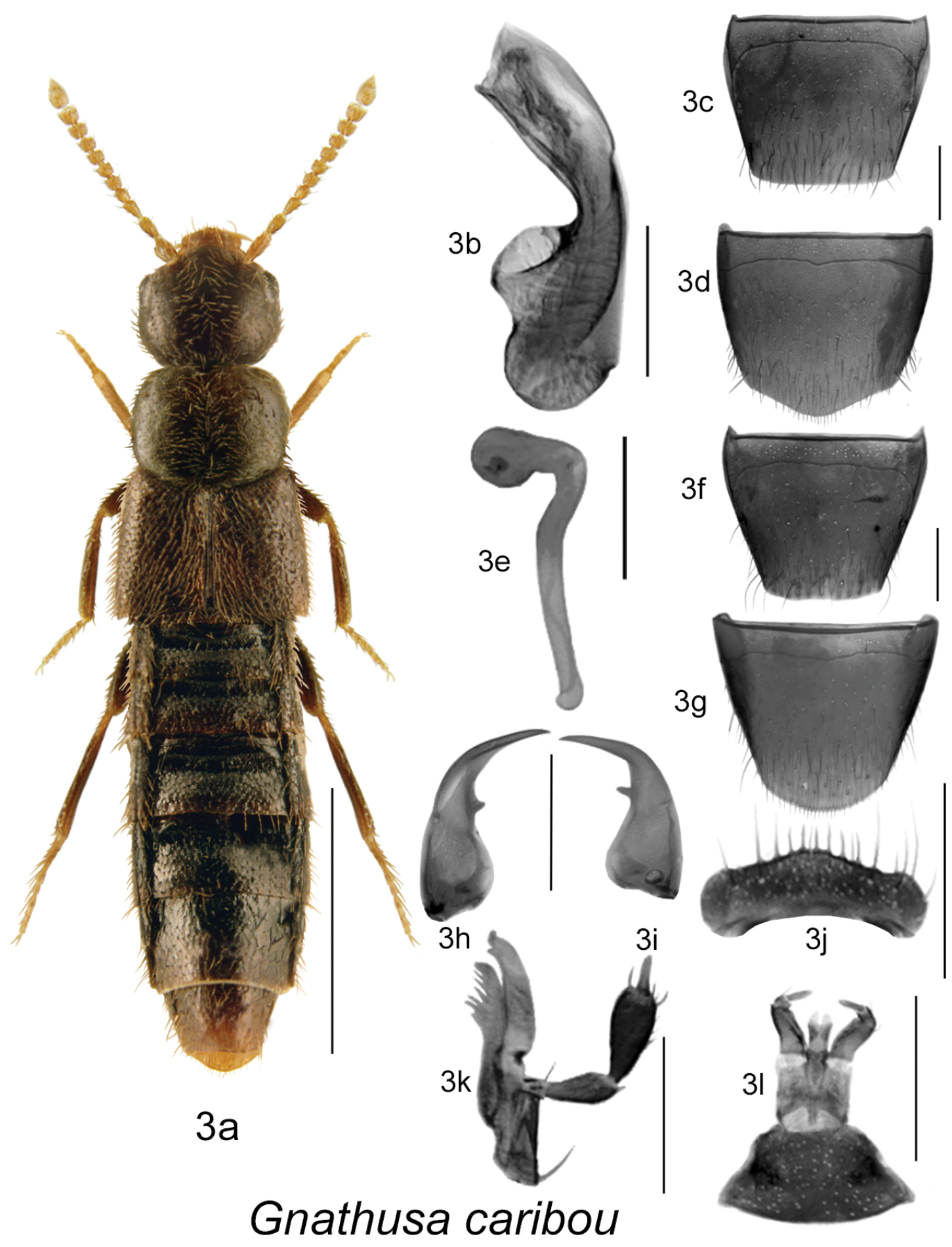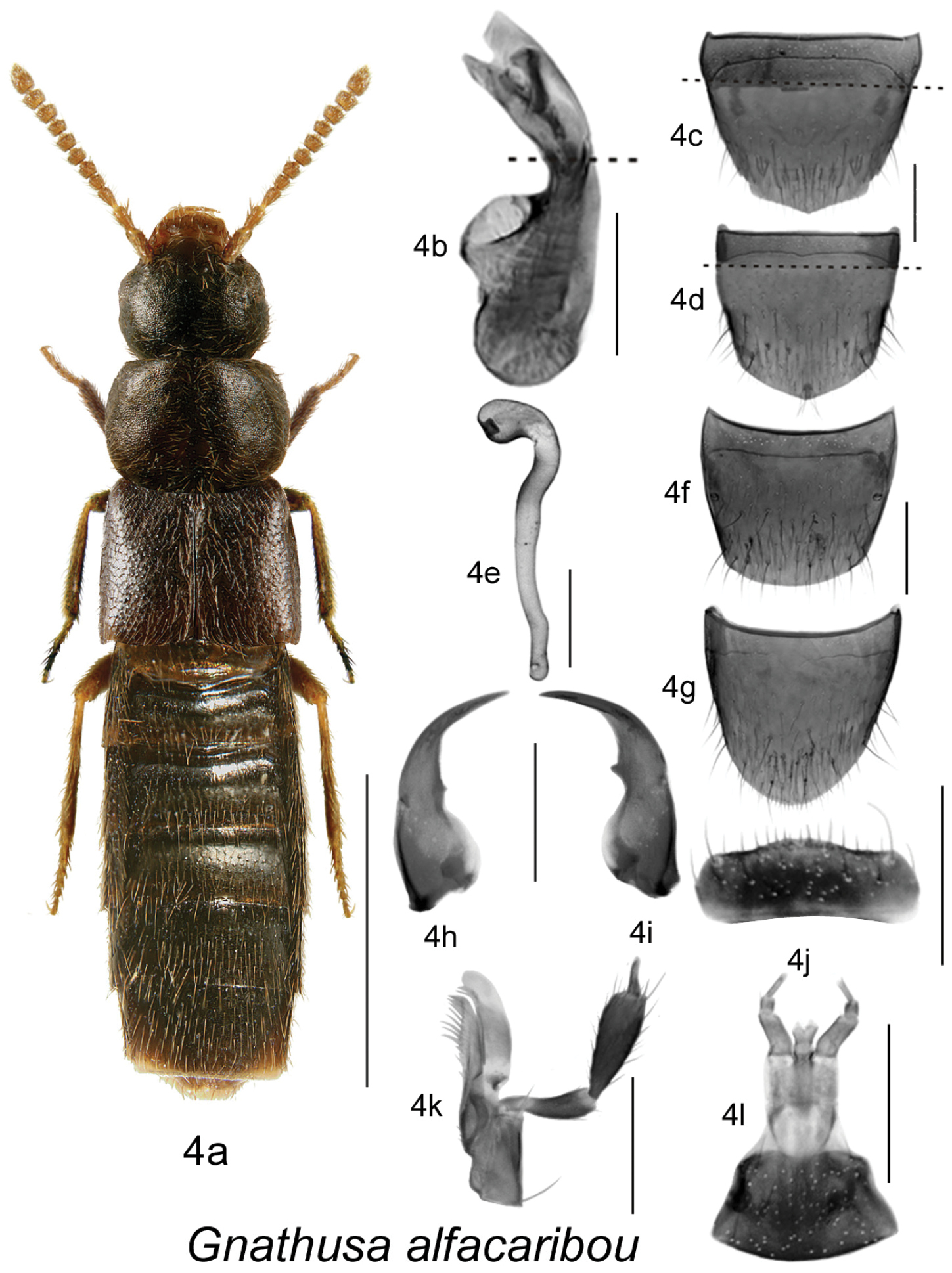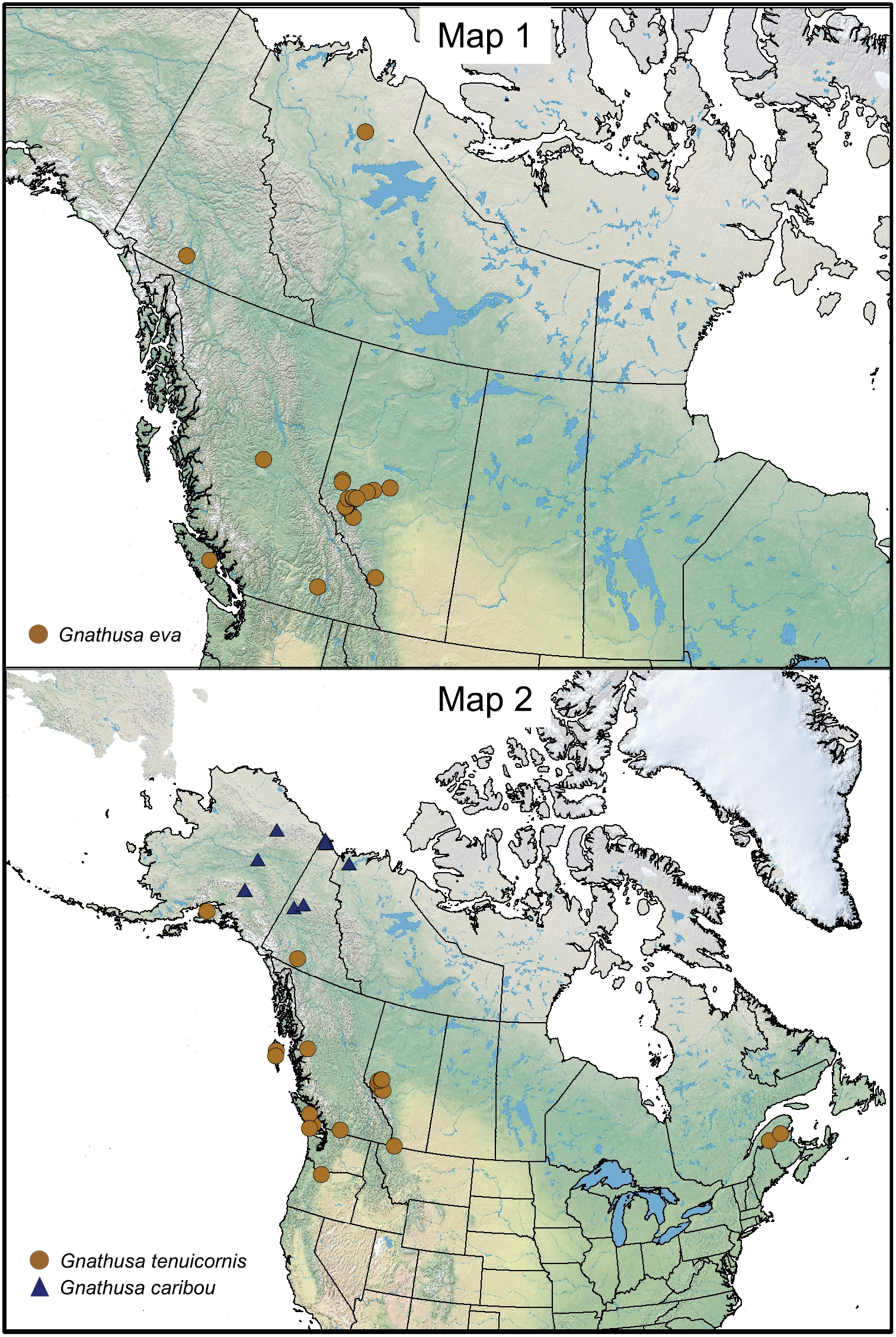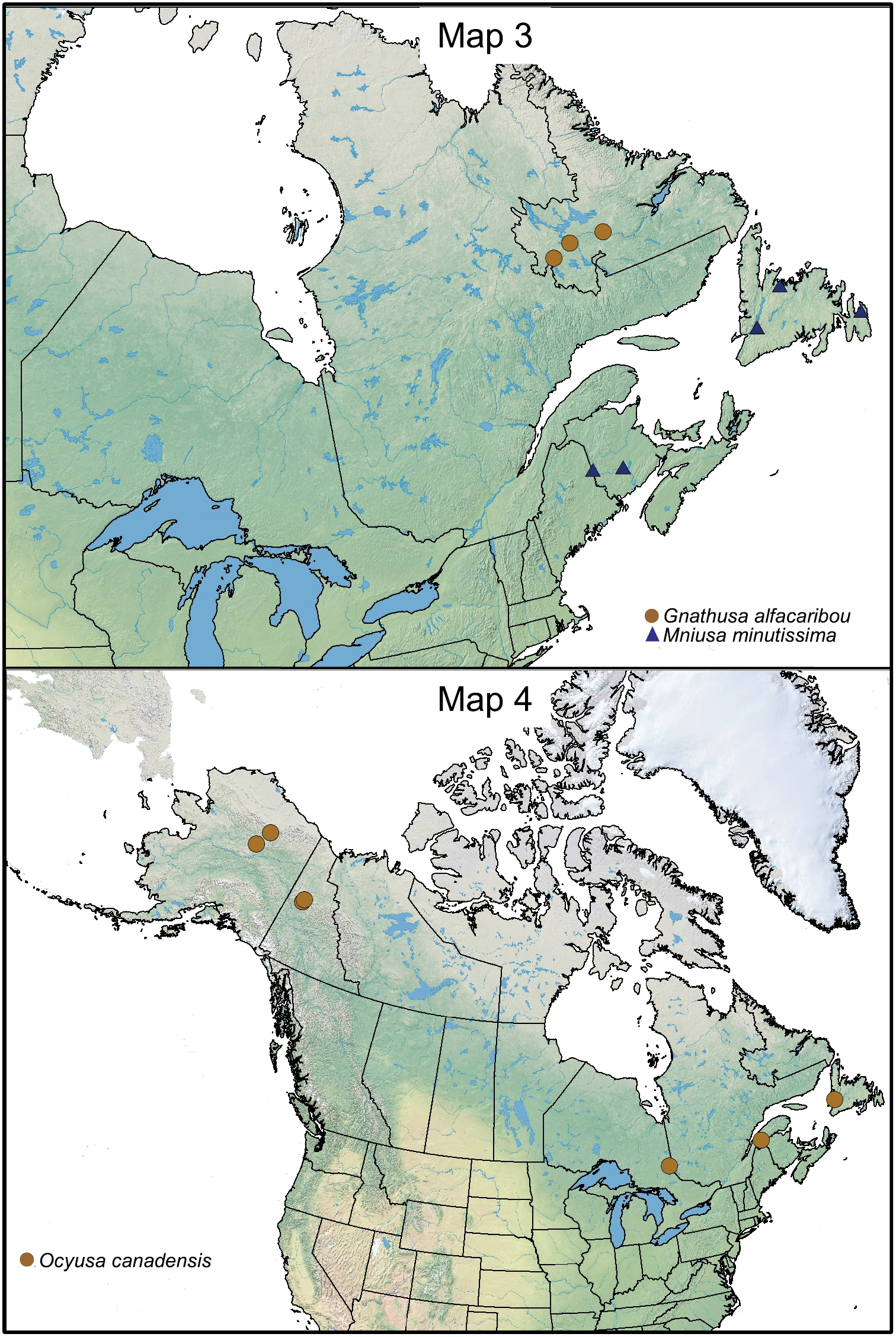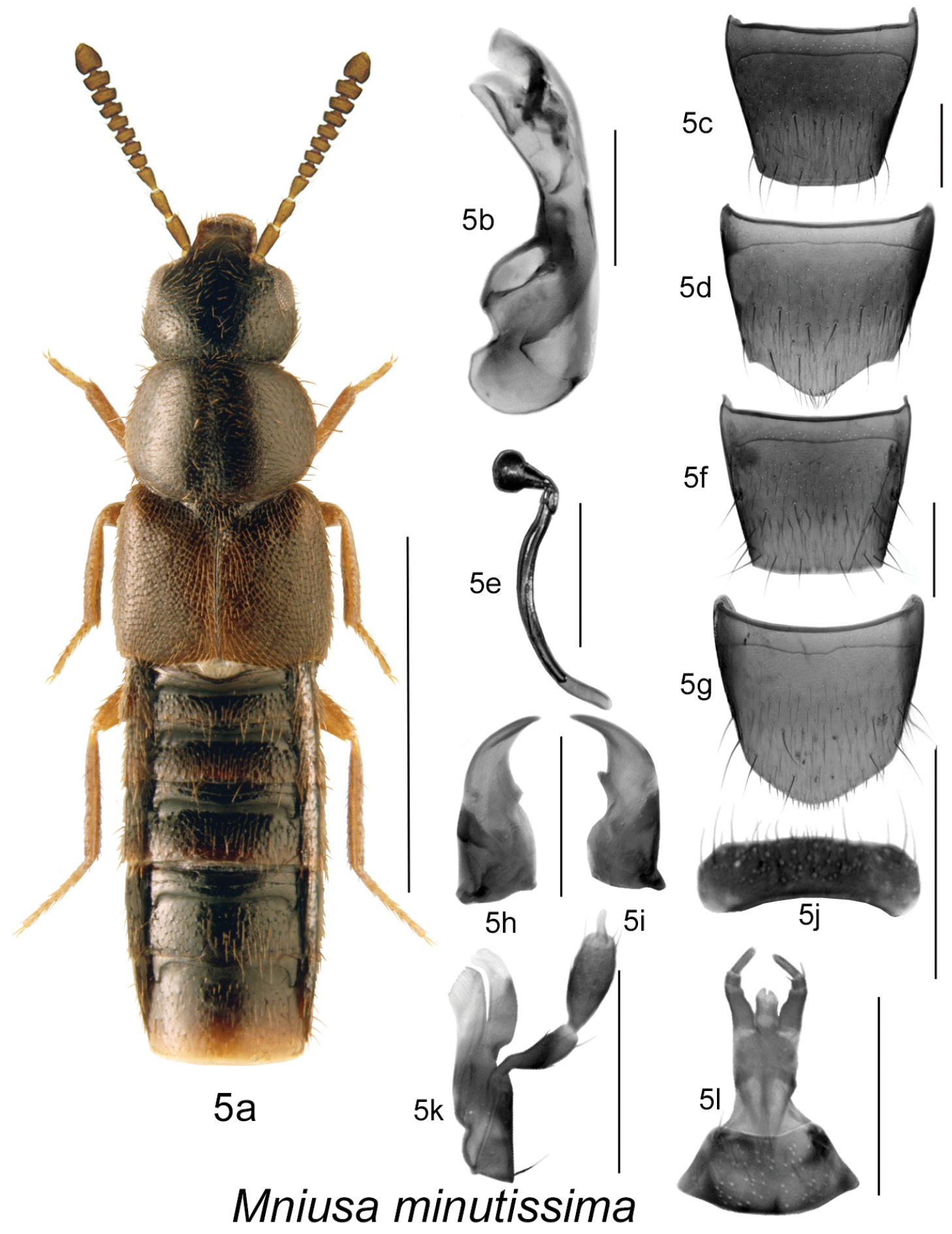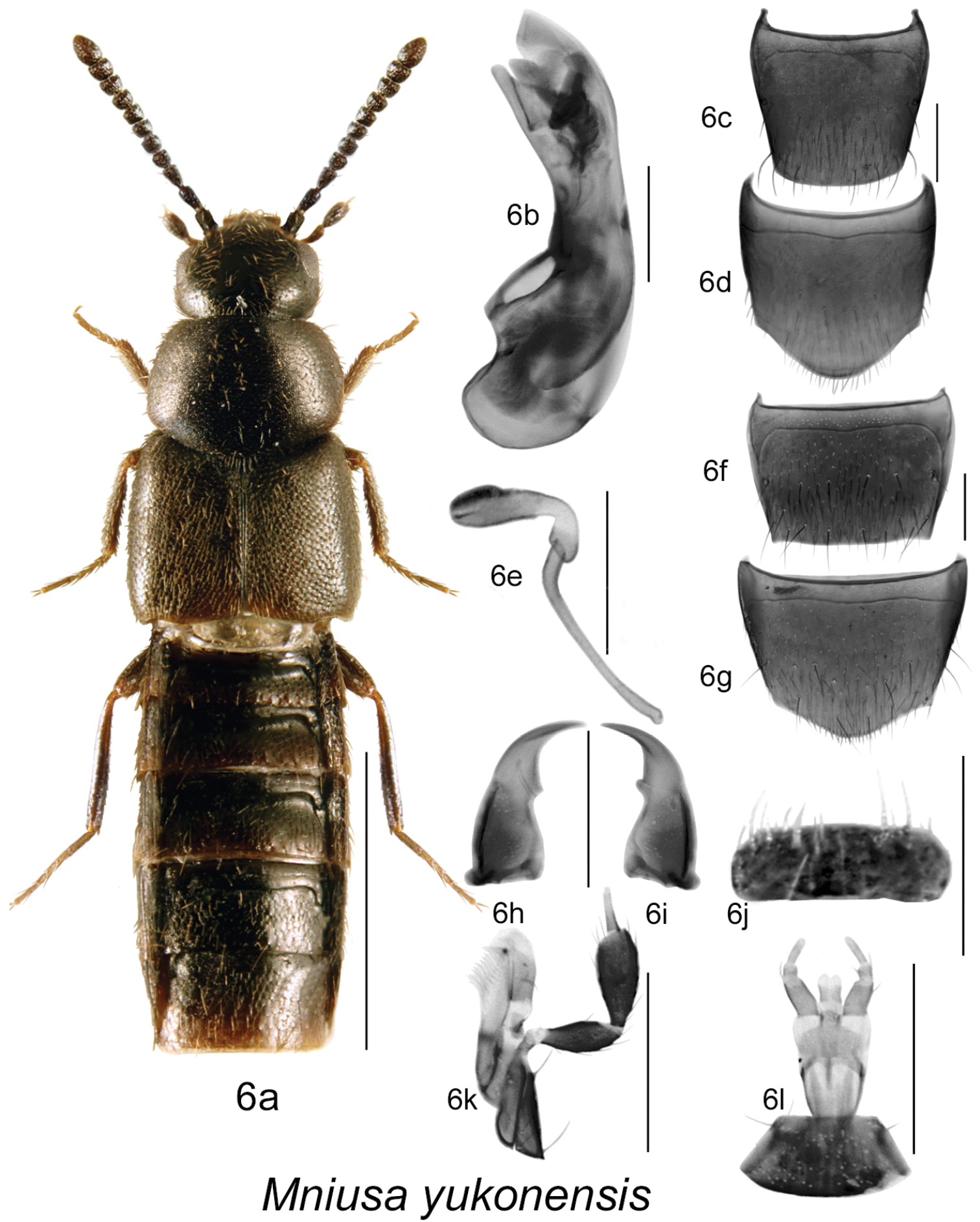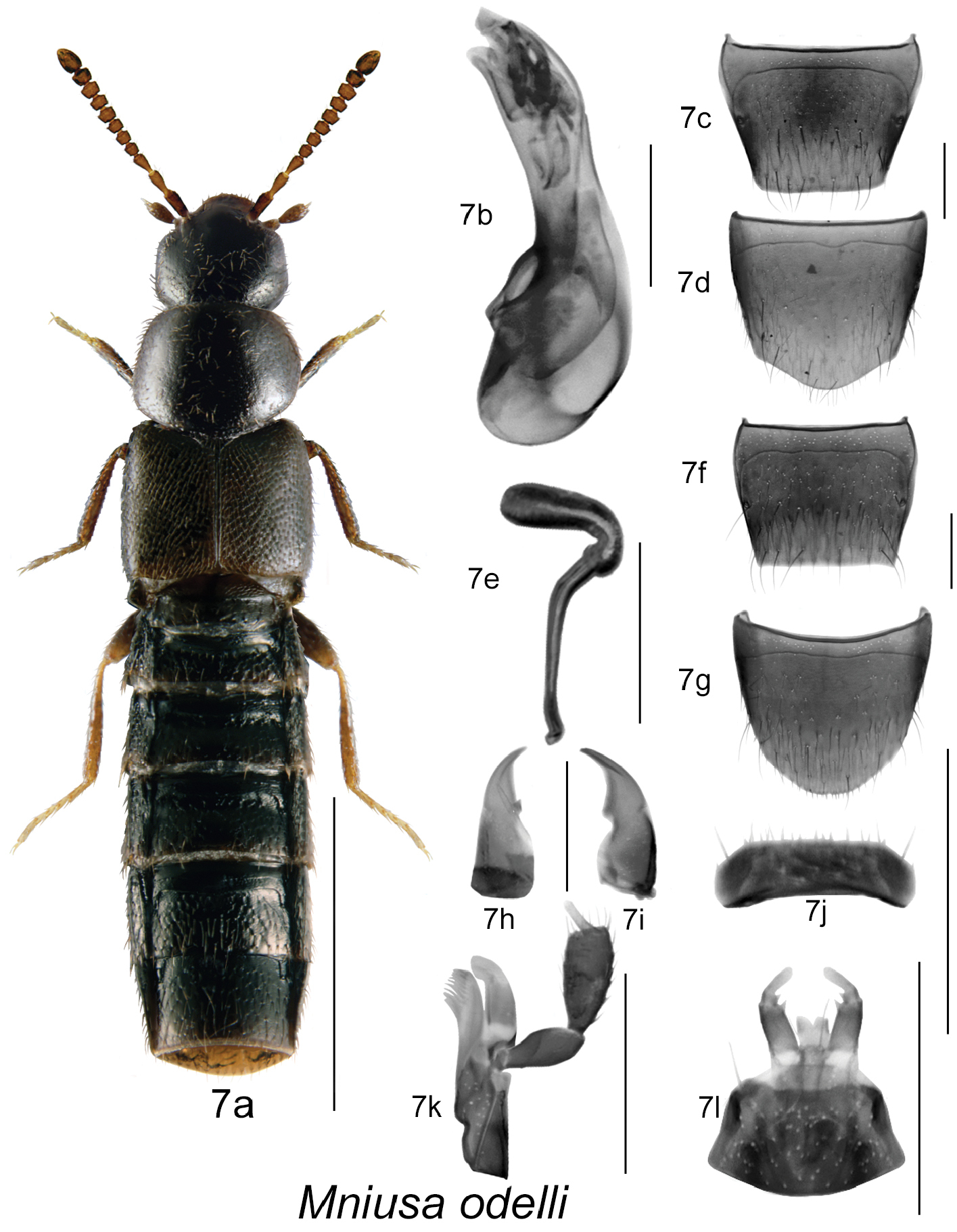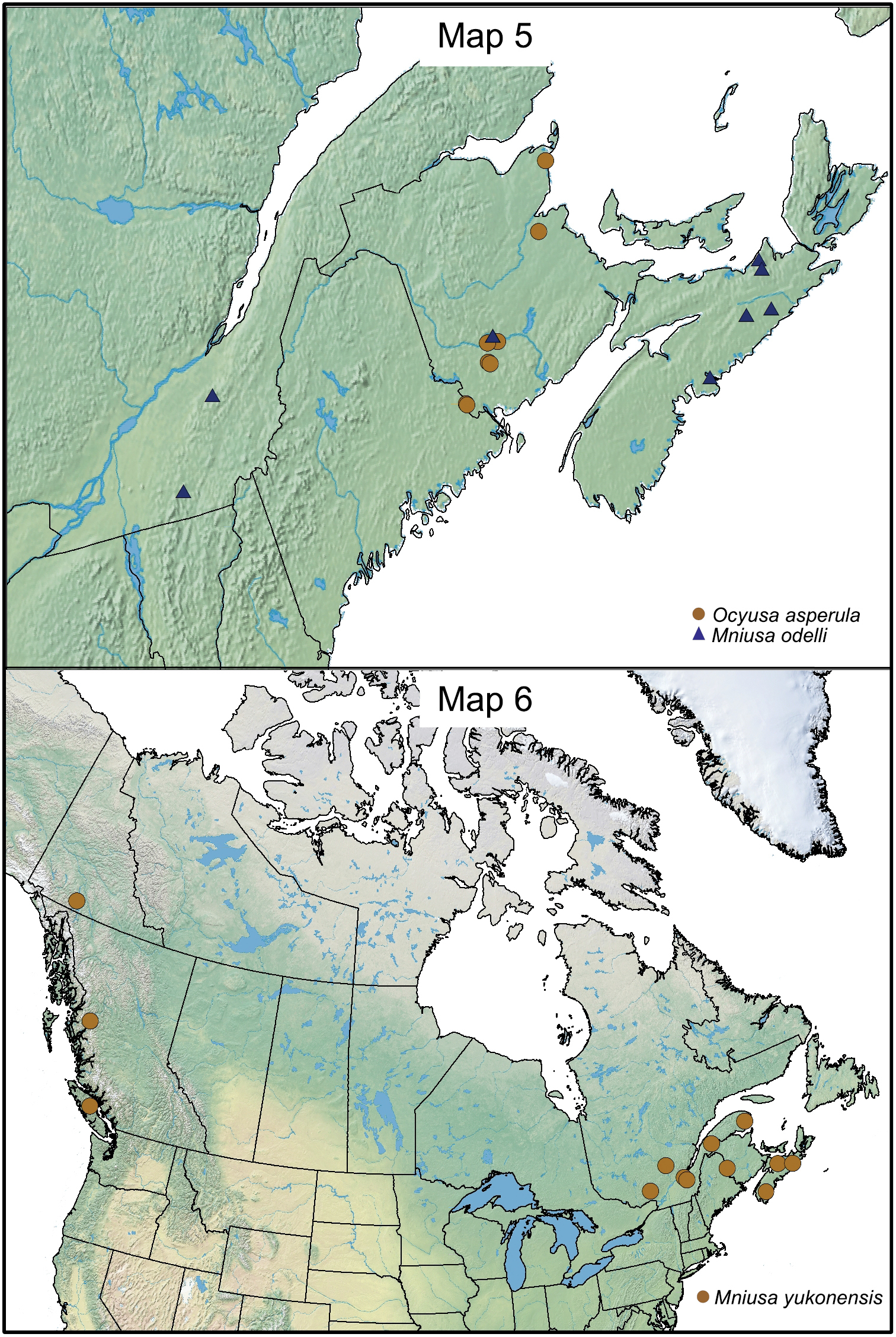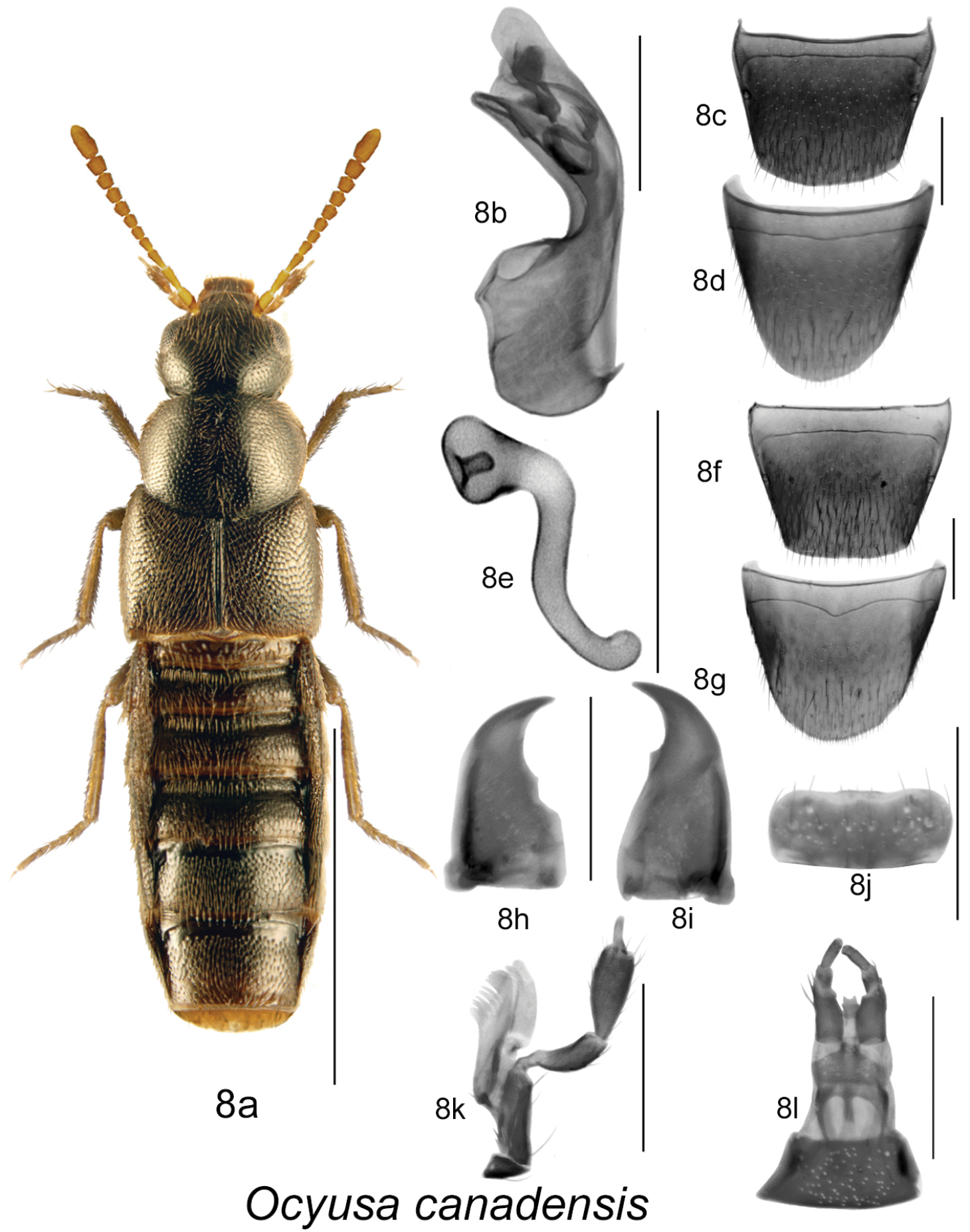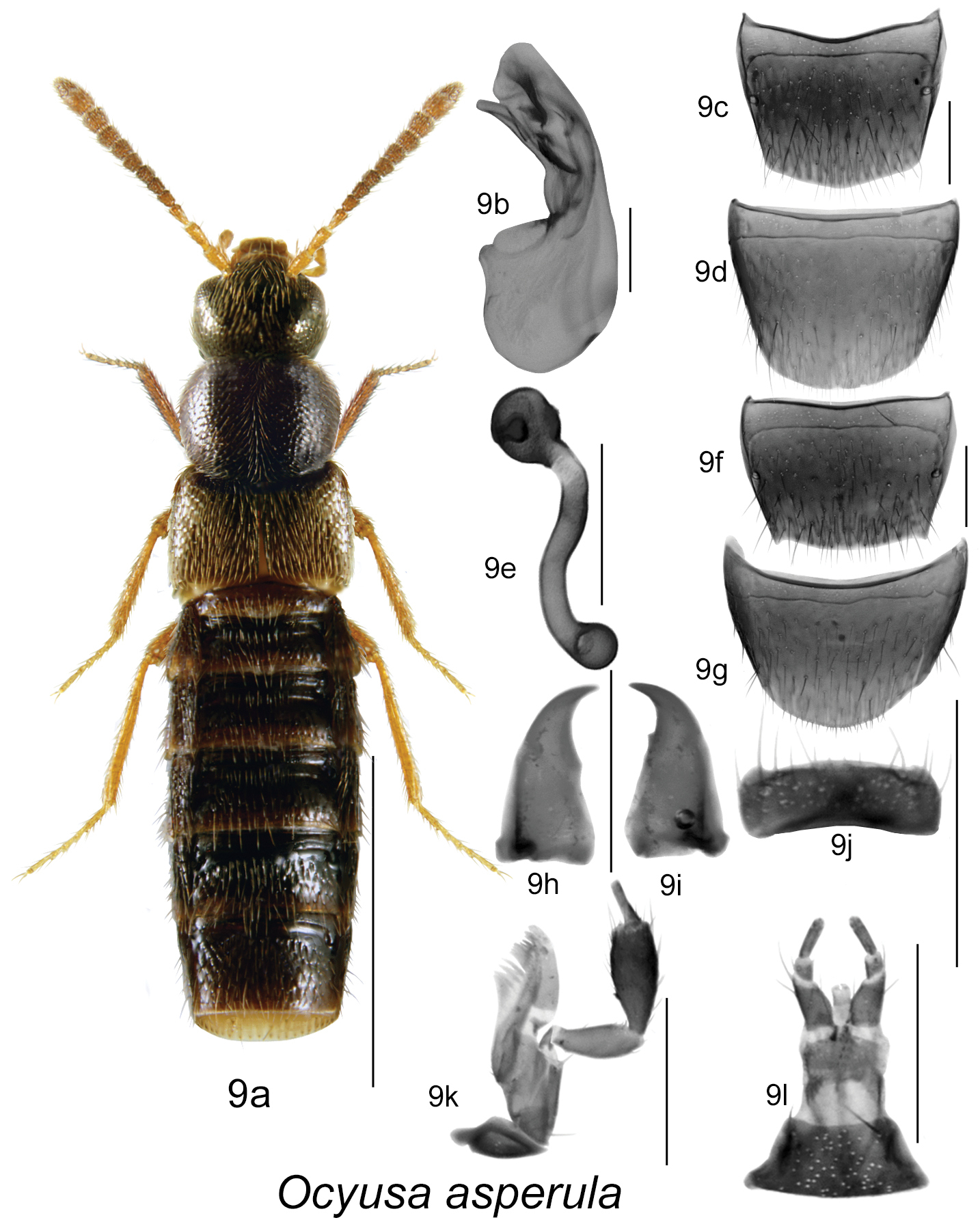






Citation: Klimaszewski J, Webster RP, Langor DW, Bourdon C, Hammond HEJ, Pohl GR, Godin B (2014) Review of Canadian species of the genera Gnathusa Fenyes, Mniusa Mulsant & Rey and Ocyusa Kraatz (Coleoptera, Staphylinidae, Aleocharinae). ZooKeys 412: 9–40. doi: 10.3897/zookeys.412.7282
Four species of Gnathusa Fenyes (G. alfacaribou Klimaszewski & Langor, G. caribou Lohse, G. eva Fenyes, and G. tenuicornis Fenyes) occur in the Nearctic and in Canada. Three species of Ocyusa Kraatz (O. asperula Casey, O. californica Bernhauer, O. canadensis Lohse), and three species of Mniusa Mulsant and Ray (M. minutissima (Klimaszewski & Langor), M. yukonensis (Klimaszewski & Godin), and M. odelli Klimaszewski & Webster, sp. n.), are known from the Nearctic and all but O. californica occur in Canada. The recently described Gnathusa minutissima Klimaszewski and Langor and Ocyusa yukonensis Klimaszewski and Godin, are transferred here to the genus Mniusa Mulsant & Rey. New provincial and state records are reported for: G. eva (Alberta), G. tenuicornis (Alberta, Oregon, and New Brunswick), O. canadensis (New Brunswick and Newfoundland), M. minutissima (New Brunswick), and M. yukonensis (Nova Scotia, New Brunswick, Quebec, and British Columbia). The female of M. yukonensis was discovered and is illustrated for the first time. The genus Mniusa is reported for the first time from Canada and represents the first confirmed generic record for North America. Keys for identification of all Canadian species, images of body and genital structures, maps showing distribution mainly in Canada, and new bionomics data are provided.
Staphylinidae, Gnathusa, Mniusa, Ocyusa, Taxonomy, Canada
Gnathusa is sometimes confused in North American collections with some species of the genus Ocyusa
Over 140 adults of the genus Gnathusa and 100 adults of Ocyusa and Mniusa from Canada and the United States were studied, and most specimens were dissected to examine the genital structures and in some cases, mouthpart structures. The genital structures were dehydrated in absolute alcohol, mounted in Canada balsam on celluloid microslides, and pinned with the specimens from where they originated. Images of the entire body and the genital structures were taken using an image processing system (Nikon SMZ 1500 stereoscopic microscope; Nikon Digital Camera DXM 1200F, and Adobe Photoshop software).
Morphological terminology mainly follows that used by
The morphology of antennae and mandibles, body proportions, density of punctures on the forebody, and the shape of the median lobe of the aedeagus and the spermatheca provide the best characteristics for species identification in Gnathusa, Mniusa and Ocyusa.
AAFC Agriculture and Agri-Food Canada, Atlantic Cool Climate Crop Research Centre, St. John’s, Newfoundland and Labrador, Canada.
AMNH American Museum of Natural History, New York, New York, USA.
CNC Canadian National Collection of Insects, Arachnids and Nematodes, Agriculture and Agri-Food Canada, Ottawa, Ontario, Canada.
ECW Environment Canada, Whitehorse, Yukon, Canada.
LFC Natural Resources Canada, Canadian Forest Service, Laurentian Forestry Centre, R. Martineau Insectarium, Quebec City, Quebec, Canada.
MUN Memorial University Collection, St. John’s, Newfoundland and Labrador, Canada [on long-term loan to David Langor at NoFC].
NoFC Natural Resources Canada, Canadian Forest Service, Northern Forestry Centre, Edmonton, Alberta, Canada.
NSPM Nova Scotia Provincial Museum, Halifax, Nova Scotia, Canada.
RWC Reginald Webster Private Collection, Charters Settlement, New Brunswick, Canada.
USNM United States National Museum, Washington, D.C., USA.
ZMB Zoological Museum of Humboldt University, Berlin, Germany.
| 1 | Mandibles extremely long and narrow, distinctly longer than width of labrum, and sickle-shaped with apices long and very slender, crossing each other in resting position, right mandible bearing a spine and the left a small tooth (Figs 1h, i, 2i, j, 3h, i, 4h, i); frontal suture between eyes absent; ligula more or less deeply bilobed (Figs 1l, 2m, 3l, 4l); anterior margin of mesosternum with short V-shaped basal carina | Gnathusa Fenyes |
| – | Mandibles moderately long and broad, each as long as the width of labrum or only insignificantly longer (Figs 5h, i, 6h, i, 7h, i, 8h, i, 9h, i), apices gradually narrowed and pointed, right mandible bearing a small tooth and the left a slightly less developed one; frontal suture between eyes present (Ocyusa) or absent (Mniusa); ligula shallowly split apically (Figs 5l, 6l, 7l, 8l, 9l); anterior margin of mesosternum without V-shaped basal carina | 2 |
| 2 | All pronotal setae distributed along midline of pronotum directed posteriad; fronto -clypeal phragma present and visible externally as frontal suture between antennal pits (seen better in diffused light); spermatheca S-shaped with spherical capsule bearing deep and broad invagination and sinuate moderately broad stem (Figs 8e, 9e); tubus of median lobe strongly produced ventrally in lateral view (Figs 8b, 9b); Canadian species are known from riparian habitats | Ocyusa Kraatz |
| – | Pronotal setae along midline of pronotum directed anteriad in about apical third of midline and posteriad elsewhere; frontal suture absent; spermathecal capsule spherical or tubular and narrowly extended forming L-shaped neck, connected to thin and elongate stem (Figs 5e, 6e, 7e); tubus of median lobe approximately straight in lateral view and slightly produced ventrally (Figs 5b, 6b, 7b); Canadian species are known from forests | Mniusa Mulsant & Rey |
http://species-id.net/wiki/Gnathusa
Body dark brown to black, compact and robust, subparallel (Figs 1a, 2a, b, 3a, 4a), length 3.5–4.3 mm; integument with distinct meshed microsculpture; head large with mandibles extremely long and sickle-shaped, apices very slender, each crossing the other in resting position, each mandible bearing long spine or tooth (Figs 1h, i, 2i, j, 3h, i, 4h, i); infraorbital carina strong and complete; ligula more or less deeply bilobed (Figs 1l, 2m, 3l, 4l); last article of maxillary palpus needle-shaped (Figs 1k, 2l, 3k, 4k); frontal suture of head absent; anterior margin of mesosternum with short V-shaped basal carina, remaining mesosternum uncarinated; mesosternal process long, triangular basally and then narrowly produced and extending to about ¾ length of mesosternal cavities, metasternal process triangular in shape and short, isthmus short; median lobe of aedeagus with large crista apicalis, internal sac structures variable in shape (Figs 1b, 2c, 3b, 4b), paramere with narrowly elongate apical lobe bearing four macrosetae; spermatheca pipe-shaped with spherical or tubular capsule and elongate narrow stem (Figs 1e, 2d, 3e, 4e).
Gnathusa eva Fenyes: 1a habitus 1b median lobe of aedeagus in lateral view 1c male tergite VIII 1d male sternite VIII 1e spermatheca in lateral view 1f female tergite VIII 1g female sternite VIII 1h left mandible 1i right mandible 1j labrum 1k maxilla 1l menthum, labial palpi and ligula. Habitus scale bar = 1.0 mm; other scale bars = 0.2 mm.
Gnathusa tenuicornis Fenyes: 2a habitus, based on female from New Brunswick 2b habitus based on male from Alberta 2c median lobe of aedeagus in lateral view 2d spermatheca in lateral view 2e male tergite VIII 2f male sternite VIII 2g female tergite VIII 2h female sternite VIII 2i left mandible 2j right mandible 2k labrum 2l maxilla 2m menthum, labial palpi and ligula. Habitus scale bar = 1.0 mm; other scale bars = 0.2 mm.
Gnathusa caribou Lohse: 3a habitus 3b median lobe of aedeagus in lateral view 3c male tergite VIII 3d male sternite VIII 3e spermatheca in lateral view 3f female tergite VIII 3g female sternite VIII 3h left mandible 3i right mandible 3j labrum 3k maxilla 3l menthum, labial palpi and ligula. Habitus scale bar = 1.0 mm; other scale bars = 0.2 mm.
Gnathusa alfacaribou Klimaszewski and Langor: 4a habitus 4b median lobe of aedeagus in lateral view, partially reconstructed below broken line in Fig. 4b, and above broken line in Fig. 4c, 4d; based on the holotype 4c male tergite VIII partially reconstructed above broken line, based on the holotype 4d male sternite VIII partially reconstructed above broken line, based on the holotype 4e spermatheca in lateral view 4f female tergite VIII 4g female sternite VIII 4h left mandible 4i right mandible 4j labrum 4k maxilla 4l menthum, labial palpi and ligula. Habitus scale bar = 1.0 mm; other scale bars = 0.2 mm.
New provincial and territorial records are indicated in boldface font.
| 1 | Labrum with coarse spines (Fig. 1j); antennal articles 7–10 strongly transverse (Fig. 1a); body length 3.5–4.0 mm; integument moderately glossy; genitalic structures as illustrated (Fig. 1b, e) | Gnathusa eva Fenyes [AB, BC, CA, YT] |
| – | Labrum with fine setae (Figs 2k, 3j, 4j); antennal articles 7-10 subquadrate or slightly transverse (Figs 2a, b, 3a, 4a); body length 2.5–3.7 mm; integument usually more glossy; genital structures differently shaped (Figs 2c, d, 3b, e, 4b, e) | 2 |
| 2(1) | Antennal articles 5–10 subquadrate (Fig. 2a, b); genitalia as illustrated (Figs 2c, d); body length 2.5–3.7 mm | Gnathusa tenuicornis Fenyes [AB, AK, BC, YT, OR, NB] |
| – | Antennal articles 5–10 slightly transverse (Figs 3a, 4a); genitalia differently shaped (Figs 3b, e, 4b, e); body length 2.8–3.6 mm | 3 |
| 3(2) | Head slightly narrower and smaller than pronotum in dorsal view (Fig. 4a); antennae brown or yellowish-brown; basal part of abdominal tergite III deeply impressed and moderately coarsely-densely punctate; genitalia as illustrated (Fig. 4b, e) | Gnathusa alfacaribou Klimaszewski & Langor [NF, LB] |
| – | Head about as wide and large as pronotum in dorsal view (Fig. 3a); antennae light yellow; basal part of abdominal tergite III deeply impressed and coarsely-densely punctate; genitalia as illustrated (Figs 3b, e; Figs 45–47, in |
Gnathusa caribou Lohse [YT, NWT, AK] |
http://species-id.net/wiki/Gnathusa_eva
Figure 1a–l, Map 1Body length 3.5–4.0 mm, sides subparallel; body colour light brown to dark brown, antennae and tarsi rust-brown, head and abdomen often dark brown; integumental microsculpture dense and surface moderately glossy; head round and almost as wide as pronotum with labrum bearing long spines; pronotum transverse, angular, wider than maximum width of elytra; elytra at suture subequal in length to pronotum; abdomen subparallel; antennal articles 6-10 moderately-to-strongly transverse, last article short and broadly oval (Fig. 1a). MALE: tergite VIII widely truncate apically (Fig. 1c); sternite VIII slightly pointed at apex (Fig. 1d); median lobe of aedeagus with tubus arcuate and apex pointed and produced ventrally in lateral view (Fig. 1b). FEMALE: tergite VIII truncate apically (Fig. 1f); sternite VIII rounded apically (Fig. 1g); spermatheca pipe-shaped, with short sac-shaped capsule and long, thin and sinuate stem, spermathecal neck weakly sclerotized and neck to capsule angle variable (Fig. 1e).
The Canadian distribution of this native Nearctic species includes Alberta [new provincial record], British Columbia (
Adults were captured in clear-cut Sitka spruce forest on Vancouver Island and in moss and gravel at the edge of small pools at other localities in the interior of British Columbia (
CANADA: Alberta: Lusk Creek, Kananaskis F.E.S., 14.VII.1971, J.M. & B.A. Campbell (CNC) 1 male, 4 females; vicinity of Swan Hills, 54°42'N, 115°23'W, Picea/Pinus forest, 15.VI.1990, D.W. Langor (NoFC) 2 males; Grande Prairie, 64 km S, 54.5597°N, 118.6633°W, emergence trap on MPB infested lodgepole pine, 14 July 2011, col. Bleiker (NoFC) 1 female; same data except 15 July 2011, 1 female, 1 sex undetermined; Grande Prairie, 75 km S, 54.4706°N, 118.6560°W, 13 Aug. 2011, emergence trap on MPB infested lodgepole pine, col. Bleiker (NoFC) 1 sex undetermined; Fox Creek, 24 km E, 54.4575°N, 116.4377°N, emergence trap on MPB infested lodgepole pine, 9 Aug. 2011, col. Bleiker (NoFC) 1 female; Fox Creek, 7 km SW, 54.3241°N, 116.8335°W, emergence trap on MPB infested lodgepole pine, 18 July 2011, col. Bleiker (NoFC) 1 sex undetermined; 20 km NW Hinton, 4 km NW of Jarvis Lake, 53.484°N, 117.854°W, Ecosite Surrogacy Study, Ecoregion: UF, Ecosite I1, Stand I103, pitfall trap # 4, 19.VI–3.VII.2004, J. Hammond et al. coll. (NoFC) 1 sex undetermined; 20 km S Hinton, 31.V.1990, pitfall trap, D. Langor (NoFC) 1 sex undetermined; 21.3 km NW Hinton, W.A. Switzer Prov. Pk., 53.529°N, 117.824°W, Ecosite Surrogacy Study, Ecoregion: UF, Ecosite E1, Stand E129, pitfall trap # 5, 3–17.VII.2004, J. Hammond et al. coll. (NoFC) 1 female; 23 km NW Hinton, 1.7 km W of Gregg Lake, 53.545°N, 117.821°W, Ecosite Surrogacy Study, Ecoregion: UF, Ecosite H1, Stand H101, pitfall trap # 1, 2–16.VII.2004, J. Hammond et al. coll. (NoFC) 1 female; 25 km NW Hinton, west side Hay River Rd., 53.502°N, 117.909°W, Ecosite Surrogacy Study, Ecoregion: UF, Ecosite C1, Stand C101, pitfall trap # 4, 2–17.VII.2004, J. Hammond et al. coll. (NoFC) 1 male; same data except: pitfall trap # 6, 17–31.VII.2004, J. Hammond et al. coll. (NoFC) 1 sex undetermined; 26 km SE Hinton, 7 km S of Gregg River Rd., 53.220°N, 117.343°W, Ecosite Surrogacy Study, Ecoregion: UF, Ecosite H1, Stand H104, pitfall trap # 1, 16.V–1.VI.2004, J. Hammond et al. coll. (NoFC) 2 sex undetermined; 32 km NW Hinton, 1 km W of Rock Lake Rd., 53.561°N, 117.998°W, Ecosite Surrogacy Study, Ecoregion: UF, Ecosite F1, Stand F104, pitfall trap # 1, 2–16.VI.2004, J. Hammond et al. coll. (NoFC) 1 male, 5 sex undetermined; 33 km NW Hinton, 3.75 km N of Highway 40, 53.594°N, 117.964°W, Ecosite Surrogacy Study, Ecoregion: UF, Ecosite E1, Stand E108, pitfall trap # 4, 4–18.VI.2004, J. Hammond et al. coll. (NoFC) 1 female, 1 sex undetermined; 34 km NW Hinton, 0.5 km W of Highway 40, Ecosite Surrogacy Study, Ecoregion: UF, Ecosite F1, Stand F102, pitfall trap # 4, 4–18.VI.2004, J. Hammond et al. coll. (NoFC) 3 sex undetermined; 35 km NW Hinton, 3.75 km N of Highway 40, 53.596°N, 118.002°W, Ecoregion: UF, Ecosite D1, Stand D109, pitfall trap # 4, 2–16.VII.2004, J. Hammond et al. coll. (NoFC) 1 female; 36 km NW Hinton, 3.75 W of Rock Lake Rd., 53.564°N, 118.046°W, Ecosite Surrogacy Study, Ecoregion: UF, Ecosite I1, Stand I107, pitfall trap # 4, 14.V–4.VI.2004, J. Hammond et al. coll. (NoFC) 1 female; 59 km NW Hinton, 3.5 km N of Polecat Rd., 53.902°N, 117.911°W, Ecosite Surrogacy Study, Ecoregion: UF, Ecosite H1, Stand H105, pitfall trap # 2, 3–17.VI.2004, J. Hammond et al. coll. (NoFC) 1 sex undetermined; 62 km N Hinton, 5 km W of J. Wright Rd., 53.969°N, 117.668°W, Ecosite Surrogacy Study, Ecoregion: UF, Ecosite F1, Stand F105, pitfall trap # 2, 12.V–2.VI.2004, J. Hammond et al. coll. (NoFC) 1 female, 1 sex undetermined; 63 km N Hinton, 3.75 km S of J. Wright Rd., 53.974°N, 117.449°W, Ecosite Surrogacy Study, Ecoregion: UF, Ecosite D1, Stand D102, pitfall trap # 2, 30.VI–14.VII.2004, J. Hammond et al. coll. (NoFC) 1 male, 1 female; 65 km N Hinton, 5 km W of J. Wright Rd., 53.995°N, 117.656°W, Ecosite Surrogacy Study, Ecoregion: UF, Ecosite E1, Stand E118, pitfall trap # 5, 30.VI–14.VII.2004, J. Hammond et al. coll. (NoFC) 1 sex undetermined; 67 km N Hinton, north side of J. Wright Rd., 53.998°N, 117.435°W, Ecosite Surrogacy Study, Ecoregion: UF, Ecosite D1, Stand D104, pitfall trap # 2, 2–16.VI.2004, J. Hammond et al. coll. (NoFC) 1 sex undetermined. British Columbia: Fort St. James, PG13B-trap 4, 10.V. 1995 (CNC) 1 female; same data except: GP 11 km-2, 1 year post harvest (CNC) 1 male; GP 115, 30.V.1996, 1 year post harvest, R. Felix (CNC) 1 male; 20.VI.1920, GP 11 km, 2 years post harvest, D. Rodriguez (CNC) 1 female; 4.VIII.1996, Tachie-Pinchi, M. Cloet, trap 5 (CNC) 1 female; GP 11 km-2, 10.V.1995, 1 year post harvest (CNC) 3 females; 21 km SW Campbell River, 49°51'55"N, 125°27'51"W, 22.V-6.VI.1996, Balsam Cr., LT 1-T, 1-E (LFC) 2 males; Monashee Mountain near Cherryville, 12.VIII.1982, R. Baranowski (LFC, MZLU) 1 female, 1 sex undetermined [published record
UNITED STATES OF AMERICA: California: Mono Co., 6 mi SW Toms Place, 9000’, 8.VIII.1969, A. Smetana (CNC) 3 males, 1 female [not shown in Map 1].
http://species-id.net/wiki/Gnathusa_tenuicornis
Figure 2a–m, Map 2Body length 2.5–3.7 mm, sides subparallel; body colour light brown to almost black, with antennae, tarsi and often elytra and apical part of abdomen rust-brown; integumental microsculpture dense and surface strongly glossy; head round (Fig. 2a) to somewhat quadrate (Fig. 2b) and almost as wide as pronotum, labrum with short fine setae but lacking coarse spines; pronotum transverse, subequal to slightly narrower than maximum width of elytra, corners somewhat angular; elytra at suture subequal in length to pronotum; abdomen subparallel; antennal articles 6–10 subquadrate, last article short and broadly oval (Fig. 2a, b). MALE: tergite VIII widely truncate apically (Fig. 2e); sternite VIII slightly pointed at apex (Fig. 2f); median lobe of aedeagus with tubus almost straight and apex pointed ventrally in lateral view (Fig. 2c). FEMALE: tergite VIII truncate apically (Fig. 2g); sternite VIII rounded apically (Fig. 2h); spermatheca pipe-shaped, with spherical capsule and long, thin, and slightly sinuate stem, neck weakly sclerotized, and neck to capsule angle variable (Fig. 2d).
This native Nearctic species was described from specimens captured in Glacier, British Columbia, later recorder from Yokon, and is herein recorded for the first time from Alberta and New Brunswick (four female specimens tentatively identified as this species) (Map 2). In the United States, this species was previously known from California (
Adults were captured in a clear-cut Sitka spruce forest on Vancouver Island and in moss and gravel at the edge of small pools in British Columbia (
CANADA: Alberta: Waterton Lakes National Park, Cameron Lake, 5450’, 4.VIII.1976, J.M. Campbell (CNC) 1 male; 20 km S Hinton, 20.VII.1989, pitfall trap, D. Langor coll., site C, trap 6, conifer study (NoFC) 1 male; 20 km S Hinton, 26.VI.1989, D. Langor coll., site C, trap 6, conifer study (NoFC) 1 male; 26 km SE Hinton, 7 km S of Gregg River Rd., 53.220°N, 117.343°W, Ecosite Surrogacy Study, Ecoregion: UF, Ecosite H1, Stand H104, pitfall trap # 4, 15–29.VI. J. Hammond et al. (NoFC) 2 males, 1 female; 31 km SE Hinton, 3 km of Highway 40, 53.593°N, 117.925°W, Ecosite Surrogacy Study, Ecoregion: UF, Ecosite D1, Stand D108, pitfall trap # 6, 11.V-3.VI. J. Hammond et al. (NoFC) 1 male; 32 km NW Hinton, 3 km W of Highway 40, 53.586°N, 117.954°W, Ecosite Surrogacy Study, Ecoregion: UF, Ecosite E1, Stand E103, pitfall trap # 5, 11.V-4.VI. J. Hammond et al. (NoFC) 1 male; 32 km NW Hinton, 1 km W of Hay River Rd., 53.760°N, 117.652°W, Ecosite Surrogacy Study, Ecoregion: UF, Ecosite I102, Stand I102, pitfall trap # 2, 13.V–3.VI. 2004, J. Hammond et al. (NoFC) 1 male, 1 female; 43 km SE Hinton, 1.5 km N Coalspur, 53.194°N, 117.046°W, Ecosite Surrogacy Study, Ecoregion: UF, Ecosite B1, Stand B103, pitfall trap # 6, 1–15.VI.2004, J. Hammond et al. (NoFC) 1 male; 55 km N Hinton, north side of Polecat Rd., 53.855°N, 117.926°W, Ecosite Surrogacy Study, Ecoregion: UF, Ecosite H1, Stand H103, pitfall trap # 3, 3–17.VI.2004, J. Hammond et al. (NoFC) 1 male, 1 female; 65 km N Hinton, 5 km W of Wright Rd., 53.995°N, 117.656°W, Ecosite Surrogacy Study, Ecoregion: UF, Ecosite E1, Stand E118, pitfall trap # 5, 2–16.VI.2004, J. Hammond et al. (NoFC) 2 females; 69.5 km N Hinton, 0.7 km NW of JV Haul Rd., 54.017°N, 117.618°W, Ecosite Surrogacy Study, Ecoregion: UF, Ecosite D1, Stand D103, pitfall trap # 5, 1–16.VI.2004, J. Hammond et al. (NoFC) 1 female. British Columbia: Glacier, Fenyes collection (CAS) 1 female [holotype]; Nitinat, Heather Mtn., subalpine meadow at 3000’, 14.VII.1979, I.M. Smith, moss on seepage slope (CNC) 1 female; Forbidden Plateau, Murray Meadows, 3400’, 21.VII.1975, J.M. and B.A. Campbell (CNC) 1 female; Queen Charlotte Islands, 10.5 km NW Rennell, Sound Rd., Ghost Main Rd., 900’, J.M. Campbell, cold moss along stream (CNC) 1 male; Queen Charlotte Islands, Moresby Is., Mt. Moresby, 25.VII.1983, 2100’, J.M. Campbell, ex gravel at edge of stream (CNC) 1 male; 20 mi E Hope, Manning Pk., 21.VI.1968, Campbell and Smetana (CNC) 1 female; Copper River Valley, A37574/P4–1-1, 6.VI–5.VII.1996, pitfall trap, J. Lemieux (LFC) 1 female; same data except: 5.VII–12.VIII.1996, (LFC) 1 male; Upper Carmanah Valley, UTM: 10U CK 803005, 16.VII-30.VII.1991, CC MT3, N. Winchester (LFC) 2 females [additional records from the same locality
UNITED STATES OF AMERICA: Alaska: Kenai Peninsula, 2 mi NE Soldotna, 10.VI.1978, Smetana and Becker (CNC) 1 female. Oregon: Mt. Hood, Timberline Lodge Road, 4500–5000’, 28.VI.1974, A. and D. Smetana (CNC) 1 male.
We have tentatively included the females from New Brunswick as belonging to this species. The difference in body colour, the slightly different shape of pronotum and the temples of the head in the New Brunswick and western specimens we attribute to infraspecific variations because the shape of spermatheca and the tergites and sternite VIII are similar in females of both populations. The study of males from New Brunswick is critical to confirm our identification. The specimens from the north usually are darker than the specimens from more southern localities in many species of aleocharines.
http://species-id.net/wiki/Gnathusa_caribou
Figure 3a–l, Map 2Body length 2.8–3.6 mm, sides narrowly subparallel; body colour dark brown to almost black, with antennae bright yellow and tarsi rust-brown to yellowish; integumental microsculpture dense and surface strongly glossy; head round, about the same size as the pronotum, labrum lacking stout spines but with fine setae of unequal length; pronotum small, transverse, angular, slightly narrower than elytra; elytra at suture subequal in length to pronotum; abdomen subparallel; antennal articles 6–10 subquadrate to slightly transverse, last article short and broadly oval (Fig. 3a). MALE: tergite VIII widely truncate apically (Fig. 3c); sternite VIII slightly pointed at apex (Fig. 3d); median lobe of aedeagus with tubus almost straight and apex pointed ventrally in lateral view (Fig. 3b). FEMALE: tergite VIII truncate apically (Fig. 1f); sternite VIII rounded apically (Fig. 3g); spermatheca pipe-shaped, with spherical capsule and long and straight stem, neck well sclerotized (Fig. 3e).
This native Nearctic species is known in Canada from the Northwest Territories and Yukon Territory (Map 2), and from Alaska (
Adults were captured from June to July in tundra by sifting organic litter under Salix, moss, and a pile of leaves stored by a rodent.
CANADA: Northwest Territories: Lac Maunoir, North shore, 19–27.VII.1969, G.E. Shewell (CNC) 1 male; Reindeer Sta., Caribou Hills, 2.VII.1972, A. Smetana (CNC) 1 male, 2 females, 1 sex undetermined [paratypes]; same label data except: 30.VI.1972 (CNC) 1 female [paratype]. Yukon Territory: British Mts., Firth River, 250 m, 69°13'N, 140°04'W, 25.VI.1984, 84–31, tundra, sifting litter under Salix (CNC) 1 male [holotype]; same label data (CNC) 1 female, 3 sex undetermined [paratypes]; British Mts., Windy Ridge, 550 m, 69°27'N, 140°25'W, 2.VII.191984, 84–46, sifting moss, J.M. Campbell (CNC) 4 sex undetermined [paratypes]; British Mts., Fish Creek, 200 m, 69°27'N, 140°23'W, 5.VII.1984, 84–58, sifting moss and arctic willow on tundra, J.M. Campbell (CNC) 1 female, 4 sex undetermined [paratypes]; British Mts., Sunday Mts., 680 m, 69°14'N, 140°05'W, 24.VI.1984, sifting pile of leaves stored by rodent, J.M. Campbell (CNC) 1 male, 2 females, 4 sex undetermined [paratypes]; Dawson City, 11.VII.1968, Campbell and Smetana (CNC) 1 male, 1 female; Dempster Hwy., mi 53, North Fork Pass, 24.VII.1978, 4200’, A. Smetana and J.M. Campbell (CNC) 1 female, 1 sex undetermined [paratypes].
UNITED STATES OF AMERICA: Alaska: Prudhoe Bay Rd., 9 mi N Atigun Pass, 68°14'N, 149°25'W, 6.VII.1978, 3100’, J.M. Campbell and A. Smetana (CNC) 1 female, 3 sex undetermined [paratypes]; mi 104.5 Denali Hwy., Brushkana Cr., 15.VII.1978, A. Smetana and J.M. Campbell (CNC) 1 sex undetermined [paratype]; mi 110 Denali Hwy., Seattle Cr., 15.VII.1978, J.M. Campbell and A. Smetana (CNC) 1 male [paratype]; mi 24, Wales Hwy., Hess Cr., 600’, 65°40'N, 149°10'W, 10.VII.1978, J.M. Campbell and A. Smetana (CNC) 1 male [non-paratype].
http://species-id.net/wiki/Gnathusa_alfacaribou
Figure 4a–l, Map 3Body length 3.0–3.4 mm, sides subparallel; body colour dark brown, with tarsi lighter and antennae brown and often with reddish tinge; head round and almost as wide as pronotum or at most as wide as pronotum, equal in size to pronotum; pronotum transverse, angular, about as wide as maximum width of elytra; abdomen subparallel, at base as wide as elytra, widest in apical half; antennal articles 5–10 quadrate to slightly transverse (Fig. 4a). MALE: tergite VIII pointed apically (Fig. 4c); sternite VIII slightly pointed at apex (Fig. 4d); median lobe of aedeagus with tubus strongly produced ventrally in lateral view, apex pointed (Fig. 4b). FEMALE: tergite VIII truncate apically (Fig. 4f); sternite VIII rounded apically (Fig. 4g); spermatheca pipe-shaped, with small spherical capsule and long, thin and almost straight stem (Fig. 4e).
This epigaeic species was collected from June to October using pitfall and flight intercept traps in black spruce-lichen, spruce-moss and old fir forests.
CANADA: Newfoundland: Labrador, Middle Brook, Lake Melville, Plot: MID 4, 17.VI.2005 (LFC) 1 male [holotype]; Labrador, Middle Brook, Lake Melville, Plot: MID 4, 17.VI.2005 (MUN) 1 male [paratype]; same data except: Plot: MID 3, 4.VII.2005 (MUN) 1 female [paratype], Plot: MID 4 (MUN) 1 female [paratype], Plot: MID 5, 18.VII.2005 (MUN) 1 female [paratype]; Labrador, Ossak Camp, Station 1, lichen-black spruce forest, 8.X.2004 (MUN) 1 female [paratype]; SW Labrador, 72 km E Labrador City, Rt. 500, km 93, 53°08.6 N, 66°05.9 W, 12–27.VIII.2001, S. and J. Peck, FIT, 600 m, spruce-moss forest 2001-34 (LFC) 1 female [paratype].
http://species-id.net/wiki/Mniusa
Body dark brown to black, compact, sides subparallel or body narrowly oval in outline (Figs 5a, 6a, 7a), length 2.0–3.2 mm; integument with distinct meshed microsculpture and moderately dense punctation and pubescence; head large with mandibles broad and long, left mandible with a small tooth (Figs 5h, 6h, 7h), and right one with a slightly larger tooth at the base of arcuate cutting edge of mandible, apices strongly narrowly elongate [more than in Ocyusa and less than in Gnathusa] (Figs 5h, i, 6h, i, 7h, i); infraorbital carina strong and complete; ligula shallowly split apically (Figs 5l, 6l, 7l); labial palpus with three articles, second article minute, last one needle-shaped (Figs 5l, 6l, 7l), and lacinia and galea as illustrated (Figs 5k, 6k, 7k); labrum narrow and transverse, apical edge entire (Figs 5j, 6j, 7j); frontal suture of head absent; pronotal pubescence along midline directed anteriad or obliquely anteriad in about apical third and posteriad or obliquely posteriad medio-basally; anterior margin of mesosternum without longitudinal carina; mesosternal process triangular basally and then produced and extending from 1/3 to almost 2/3 length of mesosternal cavities, metasternal process triangular in shape and short; isthmus short to long; median lobe of aedeagus strongly produced ventrally, internal sac structures as illustrated (Figs 5b, 6b, 7b); spermatheca with spherical or tubular capsule narrowed posteriorly into L-shaped neck, invagination narrow; stem narrowly elongate (Figs 5e, 6e, 7e).
Mniusa minutissima (Klimaszewski & Langor): 5a habitus 5b median lobe of aedeagus in lateral view 5c male tergite VIII 5d male sternite VIII 5e spermatheca in lateral view 5f female tergite VIII 5g female sternite VIII 5h left mandible 5i right mandible 5j labrum 5k maxilla 5l menthum, labial palpi and ligula. Habitus scale bar = 1.0 mm; other scale bars = 0.2 mm.
Mniusa yukonensis (Klimaszewski and Godin): 6a habitus 6b median lobe of aedeagus in lateral view 6c male tergite VIII 6d male sternite VIII 6e spermatheca in lateral view 6f female tergite VIII 6g female sternite VIII 6h left mandible 6i right mandible 6j labrum 6k maxilla 6l mentum, labial palpi and ligula. Habitus scale bar = 1.0 mm; other scale bars = 0.2 mm.
Mniusa odelli Klimaszewski and Webster: 7a habitus 7b median lobe of aedeagus in lateral view 7c male tergite VIII 7d male sternite VIII 7e spermatheca in lateral view 7f female tergite VIII 7g female sternite VIII 7h left mandible 7i right mandible 7j labrum 7k maxilla 7l menthum, labial palpi and ligula. Habitus scale bar = 1.0 mm; other scale bars = 0.2 mm.
New provincial and territorial records are indicated in boldface font.
| 1 | Antennal articles 7–10 strongly transverse and at least twice as wide as long, terminal article short and conical, no more than twice length of penultimate one (Fig. 5a); genitalia as illustrated (Figs 5b, e) | Mniusa minutissima (Klimaszewski & Langor) [NF, NB] |
| – | Antennal articles 7–10 subquadrate or moderately transverse, terminal article at least twice as long as penultimate one (Figs 6a, 7a); genitalia differently shaped | 2 |
| 2(1) | Body narrowly subparallel, with pronotum basally, elytra, and 2/3 of abdomen subequal in width, head slightly narrower than pronotum, pronotum quadrate or slightly transverse (Fig. 7a); forebody strongly glossy, sparsely punctate and pubescent; elytra at suture about as long as pronotum (Fig. 7a); median lobe of aedeagus and spermatheca as illustrated (Figs 7b, e) | Mniusa odelli Klimaszewski & Webster, sp. n. |
| – | Body broadly subparallel, pronotum strongly transverse and basally slightly narrower than elytra (Fig. 6a); forebody moderately glossy, densely punctate and pubescent; elytra at suture longer than pronotum (Fig. 6a); median lobe of aedeagus and spermatheca as illustrated (Figs 6b, e) | Mniusa yukonensis (Klimaszewski & Godin) [BC, YT, QC, NB, NS] |
http://species-id.net/wiki/Mniusa_minutissima
Figure 5a–l, Map 3Body length 2.0–2.3 mm, sides subparallel; body colour dark brown, with tarsi and often tibiae rust-brown, antennae brown; forebody with dense microsculpture, glossy and with moderately dense punctation and pubescence; head round, narrower than pronotum; pronotum transverse, rectangular in shape with sides feebly arcuate, and as wide as elytra; elytra at suture as long as pronotum (Fig. 5a); abdomen subparallel, narrower than elytra with deep basal impressions on first three visible tergites; antennae with articles V-X strongly transverse, with the outer segments at least twice as wide as long (Fig. 5a). MALE: male tergite VIII widely truncate apically (Fig. 5c); sternite VIII slightly produced at apex (Fig. 5d); median lobe of aedeagus with straight venter of tubus slightly arched laterally and internal sac with band-formed, subapical structure (Fig. 5b). FEMALE: tergite VIII truncate apically (Fig. 5f); sternite VIII rounded apically (Fig. 5g); spermatheca with small spherical capsule with small invagination, short L-shaped neck, and long, thin and broadly curved stem (Fig. 5e).
This native Nearctic species was described from Newfoundland and is herein recorded for the first time from New Brunswick (Map 3).
Adults were collected from May to July using pitfall traps in an old boreal balsam fir forest in Newfoundland; by sifting moss near a brook, sifting deep conifer litter at base of large red spruce in a mature red spruce forest, and from Lindgren funnel traps in a rich Appalachian hardwood forest in New Brunswick.
CANADA: Newfoundland: Little Grand L., 2 km E. Martin Pond, 24.VI–15.VII.1992, old fir forest, pitfall 13, (LFC) 1 male [holotype]; same data except: pitfall 19, (CFS-CB) 1 male and 1 female [paratypes]; same data except: pitfall 20, 2 males and 1 female [paratypes]; pitfall 16, 1 female [paratype]; pitfall 13, 1 female [paratype]; pitfall 20, (LFC) 1 female paratype; Little Grand L., Bakeapple Brook, 24.VI–15.VII.1992, old fir forest, pitfall 1, (CFS-CB) 1 male [paratype]; same data except: pitfall 4, 1 male; pitfall 11, 1 female [paratype]; pitfall 3, (LFC) 1 female [paratype]; Manuals R., 8 km W. St. John’s, 10.VI.1984, D. Langor, Lot, (CFS-CB) 1 female [paratype]. New Brunswick: Sunbury Co., Acadia Research Forest, 45.9799°N, 66.3394°W, 14.V.2007, 18.VI.2007 // mature red spruce and red maple forest, sifting moss near brook, R.P. Webster (LFC, RWC) 3 males, 2 females; same locality data and forest type but 14.V.2007 // sifting deep conifer litter at base of large red spruce (RWC) 2 females: Carleton Co., Jackson Falls, “Bell Forest”, 46.2200°N, 67.7231°W, 4–12.VI.2008, R.P. Webster // Rich Appalachian Hardwood Forest with some conifers, Lindgren funnel trap (RWC) 1 female; same locality data and forest type but 1–8.VI.2009, 8–16.VI.2009, R. Webster & M.-A. Giguère, Lindgren funnel trap (RWC) 2 males.
http://species-id.net/wiki/Mniusa_yukonensis
Figure 6a–l, Map 6Body length 2.8–3.0 mm, narrowly elongate and broadest at elytra; body dark brown to almost black, sometimes with reddish tinge on elytra, reddish-brown antennae and legs; forebody with dense microsculpture, dense punctation and pubescence, and strongly glossy; head round and narrower than pronotum; pronotum transverse, with sides strongly arcuate and narrowed anteriad, slightly narrower than elytra; elytra at suture about as long as pronotum or slightly longer (Fig. 6a); abdomen broadly arcuate laterally, slightly narrower than elytra and with basal impressions on first three visible tergites; antennal articles V-X slightly transverse (Fig. 6a). MALE: male tergite VIII truncate apically (Fig. 6c); sternite VIII rounded apically and slightly produced medially (Fig. 6d); median lobe of aedeagus with tubus straight and slightly produced ventrally and with complex structures of internal sac (Fig. 6b). FEMALE: tergite VIII truncate apically with slightly acute lateral angles (Fig. 6f); sternite VIII rounded apically and slightly produced apically (Fig. 6g); spermatheca with narrowly elongate sac-shaped capsule connected with L-shaped neck and narrow and long stem (Fig. 6e).
This native Nearctic species was recently described from the Yukon Territory (
Adults were collected from May to July in pitfall traps, flight intercept traps, and Lindgren funnel traps in various forest types: rich Appalachian hardwood forest with some conifers, old-growth white spruce/balsam fir forest, balsam fir and maple sugar stands, mature white spruce with feather moss, and a red spruce forest.
CANADA: Nova Scotia: Colchester Co., Debert, 6.V.1993, J. Ogden (NSPM) 1 male; Black Duck Lake, NS, 22.VI.2003, 4U: Funnel 16: 844 WPi/RSp (40-80 y), P. Dollin (NSPM) 1 male. New Brunswick: Carleton Co., Jackson Falls, “Bell Forest”, 46.2200°N, 67.7231°W, 4-12.VI.2008//, Rich Appalachian hardwood forest with some conifers, Lindgren funnel traps, R.P. Webster (RWC) 1 male, 2 females; same data except 12–19.VI.2008 (RWC) 1 female; same data except 19–27.VI.2008 (RWC) 1 female: same data except 26.V–1.VI.2009, R. Webster & M.-A. Giguère (RWC) 1 male; Restigouche Co., Dionne Brook P.N.A., 47.9064°N, 68.3441°W, 31.V–15.VI.2011 // old-growth white spruce and balsam fir forest, flight intercept trap, M. Roy & V. Webster (RWC) 1 male; same data except 31.V–1.VI.2011, Lindgren funnel trap (RWC) 3 males; same data except 15–27.VI.2011, Lindgren funnel trap (RWC) 1 female; same data except 21.VI–14.VII, 2011, Lindgren funnel trap (RWC) 1 female. Quebec: Dosquet Co., Lotb. Quebec, 27.IV.1984, Claude Chantal (LFC) 1 male; Pelegrin, North of Chandler, 48°32'N, 64°54'W, SAP Lindgren, 21.06.1994 (LFC) 1 male; Tremblant, SAP Lindgren, 28.VI.1994 (LFC) 1 female; La Tuque, SAP Lindgren, 11.VII.1994 (LFC) 1 female; St-Jacques-de-Leeds, Sapinière Quebec, 31.V.1993, 9.VI.1993, 16.VI.1993, 28.VI.1993, 30.VI.1993, Lindgren 1, 2, 4 (LFC) 6 females. British Columbia: 25 km SW Campbell River, 49°50'21"N, 125°28'34"W, 23.V-6.VI.1996, Balsam Cr. LT 5-D 10, J. Lemieux (LFC) 4 males, 1 female, 1 sex undetermined; Copper River Valley, A36435/04-1-1, 07.VI-6.VII.1996, pitfall trap, J. Lemieux (LFC) 1 male. Yukon Territory: EMAN Plot (Ecological Monitoring and Assessment Network), mature white spruce and feather moss forest, 60.5963°N, 134.9522°W, 8.VII.2003, 738 m, yellow pitfall trap (LMKM31Y), (LFC) 1 male [holotype]; EMAN Plot, 60.5963°N, 134.9522°W, 24.VII.2003, 738 m, black pitfall trap (LMKM31B), (ECW) 1 male [paratype].
http://zoobank.org/49A0754A-850F-49B6-93C2-5F630C8A61CD
http://species-id.net/wiki/Mniusa_odelli
Figure 7a–l, Map 5(female). CANADA: New Brunswick, York Co., Fredericton, Odell Park, 45.9571°N, 66.6650°W, 15.V-1.VI.2012 // Old-growth eastern hemlock forest, Lindgren funnel trap, 1 m high under Betula alleghaniensis, C. Alderson and V. Webster (LFC). PARATYPES: New Brunswick, York Co., Odell Park, 45.9539°N, 66.6666°W, 10-24.VI.2013 // Hardwood stand, Lindgren funnel trap, 1 m high under trees (RWC) 2 females.
Body length 2.8–3.2 mm, narrowly subparallel with head slightly narrower than pronotum; body colour dark brown, and with tibiae, tarsi and often basal antennal articles reddish-brown; forebody with dense microsculpture, and moderately dense punctation and pubescence, and strongly glossy; head round and slightly narrower than pronotum; pronotum slightly transverse, with sides rounded, and as wide as elytra; elytra at suture about as long as pronotum or slightly longer (Fig. 7a); abdomen subparallel, as wide as elytra and with basal impressions on first three visible tergites; antennal articles V-X slightly transverse (Fig. 7a). MALE [description of male is based on poorly preserved specimen and should be consider as tentative]: male tergite VIII truncate apically (Fig. 7c); sternite VIII rounded apically and slightly produced medially (Fig. 7d); median lobe of aedeagus with tubus straight and with complex structures of internal sac (Fig. 7b). FEMALE: tergite VIII truncate apically with sharp lateral angles (Fig. 7f); sternite VIII rounded apically (Fig. 7g); spermatheca with narrowly elongate sac-shaped capsule connected with L-shaped neck and narrow and long stem slightly sinuate posteriorly at apex (Fig. 7e).
This native Nearctic species is here described from Nova Scotia, New Brunswick, and Quebec (Map 5).
Adults were collected from May to July in Lindgren traps in an old-growth eastern hemlock stand, an old hardwood stand, and in a sugar maple forest and a red spruce forest.
This species is named after Odell Park in Fredericton, New Brunswick, where the holotype was found. This park was originally the estate of Reverend Jonathan Odell whom the park was named after. This park was established in 1954.
[specimens in poor condition and tentatively identified as this species].
CANADA: Nova Scotia: Pictou Co., Marshy Hope, 17.V.1995, ethanol lure, M. LeBlanc (NSPM) 1 sex undetermined; Antigonish Co., Fairmont Tower Road, 17.V.1995, 3-Component Lure w/+/- mcol, M. LeBlanc (NSPM) 1 female; Fairmont Tower Road, 25.V.1995, 3-Component Lure w/+/- mcol, M. LeBlanc (NSPM) 1 male, 1 female; Antigonish Co., Eigg Mountain, 25.V.1995, ethanol lure, M. LeBlanc (NSPM) 1 male, 1 female; Melopseketch Lake, Guy, 14.V–2.VI.1997, young red spruce, D.J. Bishop 201 (NSPM) 1 male; Halifax, Lake Little, 14.V–2.VI.1997, regenerating red spruce, D.J. Bishop 127 (NSPM) 1 male. Quebec: St-Jacques-de-Leeds, Erablière Québec, 28.VI.1993, Lindgren 2 (LFC) 1 female; Mont Orford, 29.VI-6.VII.1999, Lindgren 1, Erablière, 99-3-1061 (LFC) 1 male.
http://species-id.net/wiki/Ocyusa
Body dark brown to almost black, compact, sides subparallel or body narrowly oval in outline (Figs 8a, 9a), length 2.5–3.5 mm; integument with distinct meshed microsculpture and moderate to dense punctation and pubescence; head large with mandibles broad and long, left mandible with a small tooth (Figs 8h, 9h), and right one with a slightly larger tooth at the base of arcuate cutting edge of mandible, apices moderately narrowly elongate [less than in Mniusa] (Figs 8i, 9i); infraorbital carina strong and complete; ligula shallowly split apically (Figs 8l, 9l); labial palpus with three articles, second article minute, last one needle-shaped and lacinia and galea as illustrated (Figs 8k, 9k); labrum narrow and transverse, apical edge entire (Figs 8j, 9j); frontal suture of head present; pronotal pubescence along midline directed posteriad or obliquely posteriad; anterior margin of mesosternum without longitudinal carina; mesosternal process triangular basally and then produced and extending to about 2/3 length of mesosternal cavities, metasternal process narrowly triangular in shape and short; isthmus short; median lobe of aedeagus strongly produced ventrally, internal sac structures as illustrated (Figs 8b, 9b); spermatheca S-shaped with spherical capsule, short neck and elongate sinuate stem (Figs 8e, 9e).
Ocyusa canadensis Lohse: 8a habitus 8b median lobe of aedeagus in lateral view 8c male tergite VIII 8d male sternite VIII 8e spermatheca in lateral view 8f female tergite VIII 8g female sternite VIII 8h left mandible 8i right mandible 8j labrum 8k maxilla 8l menthum, labial palpi and ligula. Habitus scale bar = 1.0 mm; other scale bars = 0.2 mm.
Ocyusa asperula Casey: 9a habitus 9b median lobe of aedeagus in lateral view 9c male tergite VIII 9d male sternite VIII 9e spermatheca in lateral view 9f female tergite VIII 9g female sternite VIII 9h left mandible 9i right mandible 9j labrum 9k maxilla 9l menthum, labial palpi and ligula. Habitus scale bar = 1.0 mm; other scale bars = 0.2 mm.
| 1 | Elytra at suture shorter than pronotum (Fig. 9a); forebody strongly glossy, sparsely punctate and pubescent; median lobe of aedeagus and spermatheca as illustrated (Figs 9b, e) | Ocyusa asperula Casey [NB, RI, MA, IA] |
| – | Elytra at suture about as long as pronotum (Fig. 8a); forebody moderately glossy, densely punctate and pubescent; median lobe of aedeagus and spermatheca as illustrated (Fig. 8b, e) | Ocyusa canadensis Lohse [AK, YT, ON, NB, NF] |
http://species-id.net/wiki/Ocyusa_canadensis
Figure 8a–l, Map 4Body length 2.5–3.0 mm, narrowly elongate and broadest at elytra; body colour dark brown to almost black, with tarsi, two basal antennal articles and tibiae rust-brown, rest of antennal articles brown; forebody with dense microsculpture, moderate punctation and pubescence, and strongly glossy; head round and narrower than pronotum; pronotum transverse, rectangular in shape with sides strongly arcuate, and narrower than elytra; elytra at suture about as long as pronotum (Fig. 8a); abdomen broadly arcuate laterally, slightly narrower than elytra and with basal impressions on first three visible tergites; antennae with articles V-X subquadrate to slightly elongate (Fig. 8a). MALE: male tergite VIII broadly rounded apically (Fig. 8c); sternite VIII rounded apically (Fig. 8d); median lobe of aedeagus with tubus strongly bent ventrally and with pronounced structures of internal sac (Fig. 8b). FEMALE: tergite VIII truncate apically (Fig. 8f); sternite VIII rounded apically (Fig. 8g); spermatheca with semi-spherical capsule with long invagination, and S-shaped broad stem (Fig. 8e).
This native Nearctic species is known from Alaska, Yukon Territory and Ontario (
Some adults were collected from June to July at lake margins, on moist soil/gravel among sedges and by treading Carex and grasses.
CANADA: Newfoundland: George’s Lake, Corner Brook, 29.VII.1972, J.M. Campbell (CNC) 1 male; New Brunswick: Restigouche Co., Wild Goose Lake, 419 m elevation, 47.8540°N, 68.3200°W, 21.VII.2010 // lake margin, on moist soil/gravel among sedges, R.P. Webster (RWC) 1 female; same data except: 420 m elevation, 47.8543°N, 68.3219°W, 7.VI.2011 // lake margin with emergent Carex and grasses, treading Carex and grasses, R.P. Webster (RWC) 1 male; same data except 20.VI.2011, (RWC) 2 males, 4 females. Ontario: Timiskaming Distr., 52 km South Armstrong, 27.VI.1973, R. Parry and J.M. Campbell (CNC) 4 females, 7 sex undetermined; 52 km S Armstrong, 27.VI.1973, R. Parry and J.M. Campbell (CNC) 1 female. Yukon Territory: Dempster Hwy., mi. 122, 20.VII.1978, 2000 feet, A. Smetana and J.M. Campbell (CNC) 2 males, holotype and paratype; Dempster Hwy., mi. 147, 1900 feet, 22.VII.1978, J.M. Campbell and A. Smetana (CNC) 1 sex undetermined.
UNITED STATES OF AMERICA: Alaska: Prudhoe Bay Rd., Bonanza Creek, 900 feet, 66°40'N, 150°40'W, 2.VII.1978, A. Smetana and J.M. Campbell (CNC) 1 paratype sex undetermined; Nutirwick Creek, 67°55'N, 149°45'W, 2300 feet, 8.VII.1978, J.M. Campbell and A. Smetana (CNC) 2 sex undetermined.
http://species-id.net/wiki/Ocyusa_asperula
Figure 9a–l, Map 5Body length 2.8–3.0 mm, sides subparallel; body colour dark brown, with tarsi, two basal antennal articles and legs rust-brown, rest of antennal articles dark brown; forebody with moderately dense microsculpture, punctation and pubescence, and strongly glossy; head round and about as wide as pronotum; pronotum transverse, with sides strongly arcuate, widest in apical third, and as wide as elytra; elytra at suture much shorter than pronotum (Fig. 9a); abdomen broadly arcuate laterally, slightly broader than elytra at middle and with basal impressions on first three visible tergites; antennae with articles V-X subquadrate (Fig. 9a). MALE: male tergite VIII with apical margin slightly pointed medially (Fig. 9c); sternite VIII rounded apically (Fig. 9d); median lobe of aedeagus with tubus convex basally and then strongly bent ventrally and with complex structures of the internal sac (Fig. 9b). FEMALE: tergite VIII truncate apically with small projections laterally (Fig. 9f); sternite VIII rounded apically (Fig. 9g); spermatheca with small spherical capsule with long and broad invagination, and S-shaped broad stem slightly swollen posteriorly (Fig. 9e).
This native Nearctic species was described from Rhode Island by
Some adults were collected from April to July at lake margins, on moist soil/gravel among sedges, and by treading emergent Carex and grasses.
CANADA: New Brunswick: Charlotte Co., 3 km SW of King Brook Lake, 45.3194°N, 67.4414°W, 27.V.2007 (RWC) 1 sex undetermined; 3.0 km NW of Pomeroy Ridge, 45.3059°N, 67.4343°W, 5.VI.2008 (RWC) 1 sex undetermined; Gloucester Co., ca. 1.5 km NE of Six Roads, off Paleot Rd., 47.6292°N, 64.8565°W, 32.V.2010, R.P. Webster (RWC) 1 sex undetermined; Northumberland Co., Goodfellow Brook PNA, 46.8943°N, 65.3796°W, 23.V.2007 (BM) 1 sex undetermined; York Co., New Maryland, off Hwy 2, E of Baker Brook, 45.8760°N, 66.6252°W, 6.IV.2005 (RWC) 1 male; near Mazerolle Settlement, 45.8987°N, 66.7903°W, 9.IV.2006, R.P. Webster (LFC, RWC, NBM) 6 males, 3 females; 9.2 km W of Tracy off Rt. 645, 45.6837°N, 66.8809°W, 22.V.2008 (RWC) 1 female; ca. 14 km SW of Tracy, S of Rt. 645, 45.6603°N, 66.8603°W, 2.VII.2010, R.P. Webster (RWC) 1 sex undetermined.
We are grateful to the following individuals for lending us additional material for studies: Anthony Davies (CNC), Christian Hébert (LFC), Chris Majka (NSPM), Jeff Lemieux (formerly UBC), Joachim Willers (ZBM), and Shockley Floyd (USNM). We thank Pamela Cheers (LFC) for editing the first draft of the manuscript. We thank C. Alderson, Katie Burgess, Marie-Andrée Giguère, Cory Hughes, Michelle Roy, and Vincent Webster for technical assistance and collecting specimens. Principal funding was provided by Natural Resources Canada - Canadian Forest Service and the Canadian Food Inspection Agency. The USDA APHIS funded the study on early detection of invasive cerambycids that provided many specimens collected in Lindgren funnel traps in New Brunswick. The New Brunswick Wildlife Trust Fund funded various insect surveys over the past 8 years, which also contributed specimens to this study. We thank the Meduxnekeag River Association for permission to sample beetles at the Meduxnekeag Valley Nature Preserve, which includes the Bell Forest and the New Brunswick Department of Natural Resources (Fish and Wildlife Branch) for issuing permits for sampling in the Protected Natural Areas and for providing logistical support. Survey work in the Jacquet River Gorge Protected Natural Area was organized through the New Brunswick Museum with external funding from the New Brunswick Environmental Trust Fund, the Salamander Foundation, and the New Brunswick Wildlife Trust Fund. We are grateful to the anonymous reviewers for their constructive criticism.
